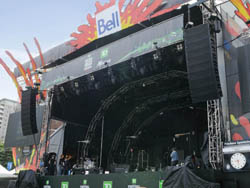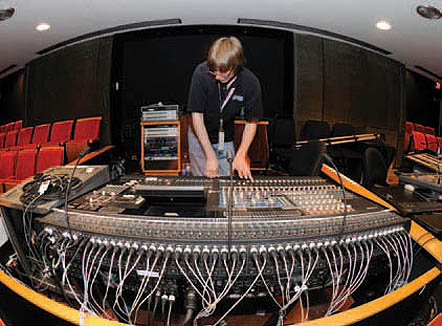
System Mainstays
This year, Solotech supplied the festival’s stages and venues with approximately 400 loudspeakers, 250 stage monitors, 50 mixing consoles, more than 1,000 microphones and DIs, and about 100 wireless mic systems, all backed by a tech team of 25 employees.
As could be expected with Meyer Sound’s involvement, a wide range of the company’s self-powered line arrays and loudspeakers were a mainstay of the main house and monitor systems, many of them fine-tuned with Galileo 616 digital signal processing.
Select acts preferred to utilize some of their own consoles and effects gear, such as Montreal band Beast, who performed to a massive crowd via mixes on Midas analog consoles at house (XL4) and monitors (H3000).
“They also had a ton of outboard gear and effects,” Tardif adds. “It’s rare that artists come with their own equipment, because it’s usually much easier to just show up with their instruments and a sound engineer.”
The system for the main stage, he notes, is usually an easier one to configure. This year, Meyer MILO 4-way curvilinear arrays flanked the stage, with more flown MILO arrays on delay extending coverage considerably further.
“It’s a large open space, but it’s challenging to place delay towers because the production staff wants to put them wherever they want,” he explains.
“That particular site has a building, the Museum of Contemporary Art, along one side, which we’ve been dealing with for years. We basically steer a line array a bit to cover as much as possible while reaching the full length of the site. It’s quite long and narrow.”

The main stage house and monitor systems were served by a pair of Yamaha PM5D digital consoles. “We needed the recall,” Tardif states. “We also put a rack with preamps on stage so that both consoles can access their local preamps or the distance preamps, giving users 96 inputs total – 48 at each location.”
Different Approach
Another new location was created this year for the Loto Quebec stage, which was served by recently introduced Meyer JM-1P full-range, arrayable point-source loudspeakers rather than line arrays.
“This stage is located in a green space, an open space, but it’s surrounded by condominiums and businesses,” Tardif says.
“We didn’t want a cabinet that would throw too far, because we knew that would become an issue at night with people living and working nearby. The throws of the horns would be too much using a system any larger than what was employed.
“We were able to cover the whole area using just six boxes – three per side,” he continues. “There were no issues with weight, no issues with power, just the box doing its job. It was great.”
Each JM-1P contains a 15-inch woofer joined by a 4-inch compression driver with a proprietary manifold coupled to a constant-Q horn that provides a 20-degree horizontal by 60-degree vertical coverage.
Components are driven a proprietary 2-channel, class AB/H power amplifier with complementary MOSFET output stages yields an output of 1,275 watts.
The loudspeakers were joined by two Meyer 700 HP dual-18 subwoofers per side on the deck, all tied together with Galileo 616 digital processing.
House mix engineers helmed a Midas XL200 console and had several outboard effects devices available to deploy as needed, including TC Electronic M3000 reverbs, Yamaha SPX9909 multi-effects processors and BSS DPR-402/404 compressors and BSS-504 gates.
A Soundcraft SM24 console anchored the monitor position, joined by Klark-Teknik digital equalization for the JBL JRX115 (single-15) and JRX215 (dual-15) 2-way loudspeakers on stage.
